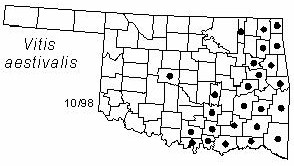Woody vine climbing to 10 m (33 ft) or higher, sometimes forming bushy clumps. Branches tomentose when young but soon becoming glabrous. Tendrils branched. Leaves suborbicular to quadrate-rotund, 7-20 cm (2.8-7.9 in) long and as wide or wider, irregularly and coarsely toothed, unlobed to deeply 3- or 5-lobed, dull green and glabrous above, usually thickly cobweb-hairy below. Inflorescence a dense compound panicle 5-15 cm (2-6 in) long, flowering in late Spring or early Summer. Fruits black or purple, 5-14 mm (0.2-0.6 in) in diameter, ripening in Fall.
Distribution: Native to the northeastern U. S. southwestward to Texas.
Habitat: Dry upland forests, bluffs, ravines, fencerows.
NWI status: none
Comment:The fruits vary widely in taste and juice content, but are often used to make wild grape jelly. Many species of wildlife eat the fruits. Vitis is the old Latin name for grape; aestivalis refers to the blooming of the flowers in the summer.
Distribution in Oklahoma: 
BACK
NEXT
RETURN TO INDEX
Last update: 9/22/99
 Go to Oklahoma Biological Survey Home Page
Go to Oklahoma Biological Survey Home Page
 Disclaimer
Disclaimer